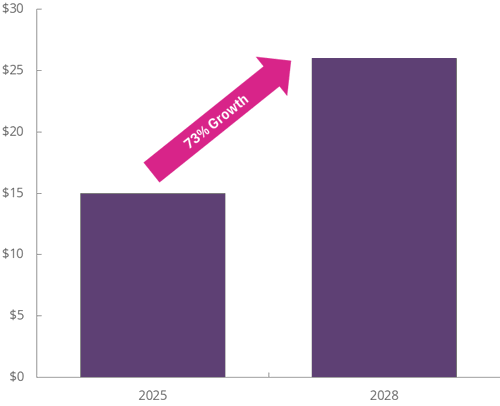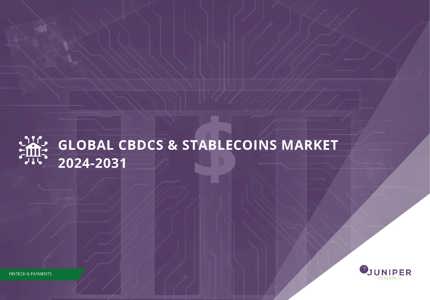Are Stablecoins Still Riding the Wave of the Future?
Over the past few years, digital currencies, and stablecoins more specifically, have been a high-profile topic within fintech & payments - being touted as the future of money on a regular basis.
As with any new development, there has been a significant amount of hype and noise around this, but until recently, little evidence of what impact stablecoins are actually having on the ground. However, the picture is now clearing up, with stablecoins having high potential across numerous areas. Indeed, stablecoins have hit a market cap of almost $280 billion as of August 2025; an increase of over $100 billion since the same point last year.
So what does this growth mean for the fintech and payments market? Stablecoins have broad potential, but examining use cases is important to understanding what this potential will look like on the ground.
Cross-border Payments
Cross-border transactions are the biggest potential area for stablecoin adoption, fundamentally because cross-border transactions are complex, costly and difficult to track under current models. Cross-border payments typically involve multiple layers of correspondent banks, meaning that to send money requires multiple stages, multiple parties receiving fees, and a costly FX conversion.
While newer players such as Wise and Revolut have been improving this by building more efficient networks, with Nium and Thunes targeting this market from an infrastructure angle, the market is still a complex one.
Stablecoins can have a major impact on this. As their value is set to a linked fiat currency, they have a set value, and critically can be sent and received across borders to different wallet addresses, regardless of physical location. This has the potential to unlock far cheaper and faster cross-border payments, and we expect this to have a major impact in markets such as remittances.
Programmable Money
One of the ideal scenarios for digital transformation of money is that it can become fully programmable. Under this scenario, a digital currency could be tied to whatever scenario is required using a smart contract. This would enable financial transactions to become a seamless, programmable layer, in the same way that many other components and APIs act.
While this has been attempted with some payment methods such as virtual cards, these have their limitations as they rely on card acceptance rails. Stablecoins can be seen as the future of programmable money – they have a set and predictable value, and can be integrated easily into digital processes. As such, they have strong potential for transformation.
Storing Value in Unstable Economies
Central to stablecoins is their stability and predictable value; particularly given the overwhelming majority of stablecoins in circulation are USD denominated. This creates opportunities for the use of stablecoins in economies where the currency is unstable.
For example, recent months have seen economic instability in Venezuela, where economic sanctions have contributed to a major economic issue, with the Venezuelan Bolivar declining by 73% versus the US dollar in the past year. As such, demand for US dollars in Venezuela has been high, but restrictions by the government have limited the ability for Venezuelans to access foreign currencies. As such, Venezuelan interest in stablecoins has spiked.
In scenarios such as this, broad access to stablecoins will allow users in disrupted economies to preserve their wealth when hyperinflation and economic issues emerge.
Why Stablecoins Aren't the Whole Solution
While as we have seen stablecoins are high impact, particularly across those three use cases, they are not the whole solution by themselves.
Stablecoins, similar to any other payment method, still need on and off ramps. As stablecoins are not ubiquitous and cannot be used for everyday transactions, there has to be a way for money to be added and withdrawn from stablecoin wallets. This creates the same network challenge as other payment methods, and means that institutions using stablecoins will need to partner to enable pay ins and pay outs. In the remittance example, it is no problem to send money to a relative in another country, but if they cannot access that money, it is useless to them.
Conclusion
It is clear that stablecoins have strong potential to transform the way payments work, however while great progress is being made, we are still in the early stages of that transformation. What we need to see is greater support and involvement from financial institutions in terms of providing access to and operationalising stablecoins, which will help to bridge the cryptocurrency and everyday finance worlds.
This is a process that is already starting to happen. Major financial institutions are starting to invest in stablecoin services, and indeed have already begun to use this for areas such as cross-border payments. This can be seen our latest data on the subject, which shows that financial institution savings are set to hit $26 billion in 2028 alone from stablecoin use.
Global Savings to Financial Institutions from Stablecoin Use ($bn), 2025 vs. 2028

Source: Juniper Research
As such, we expect financial institutions to increasingly engage with stablecoins. It will take time for stablecoins to touch different use cases, but we expect cross-border payments in particular to see strong disruption; transforming the way money is sent and received.
Nick Maynard is VP of Fintech Market Research at Juniper Research, where he leads analysis on key trends shaping the future of finance. With deep expertise across digital payments and commerce, his recent work includes reports on Chargeback Management, Digital Commerce, and Payment Card Technologies; helping stakeholders stay ahead in a rapidly evolving market.
Latest research, whitepapers & press releases
-
 ReportDecember 2025
ReportDecember 2025AI Agents for Customer Experience Platforms Market: 2025-2030
Our comprehensive AI Agents for Customer Experience Platforms research suite comprises detailed assessment of a market that is set to disrupt mobile communications. It provides stakeholders with insight into the key opportunities within the AI agents for customer experience platforms market over the next two years.
VIEW -
 ReportDecember 2025Fintech & Payments
ReportDecember 2025Fintech & PaymentseCommerce Fraud Prevention Market: 2025-2030
Our eCommerce Fraud Prevention research suite provides a detailed and insightful analysis of this evolving market; enabling stakeholders from financial institutions, law enforcement agencies, regulatory bodies and technology vendors to understand future growth, key trends, and the competitive environment.
VIEW -
 ReportNovember 2025Telecoms & Connectivity
ReportNovember 2025Telecoms & ConnectivityeSIMs & iSIMs Market: 2025-2030
Juniper Research’s eSIMs and iSIMs research suite offers insightful analysis of a market set to experience significant growth in the next five years. The research suite provides mobile network operators (MNOs), original equipment manufacturers (OEMs), and eSIM management and platforms vendors with intelligence on how to capitalise on the market growth, and guidance on how eSIM-only devices and sensors, SGP.42, in-factory provisioning, and iSIMs will change the competitive landscape.
VIEW -
 ReportNovember 2025Fintech & Payments
ReportNovember 2025Fintech & PaymentsModern Card Issuing Platforms Market: 2025-2030
Our Modern Card Issuing Platforms Market research suite provides a detailed and insightful analysis of this evolving market; enabling stakeholders from banks, financial institutions, fintech companies, and technology vendors to understand future growth, key trends, and the competitive environment.
VIEW -
 ReportNovember 2025Fintech & Payments
ReportNovember 2025Fintech & PaymentsDigital Wallets Market: 2025-2030
Our digital wallets research suite provides detailed analysis of this rapidly changing market; allowing digital wallet providers to gain an understanding of key payment trends and challenges, potential growth opportunities, and the competitive environment.
VIEW -
 ReportOctober 2025Fintech & Payments
ReportOctober 2025Fintech & PaymentsDigital Identity Market: 2025-2030
Juniper Research’s Digital Identity research suite provides a comprehensive and insightful analysis of this market; enabling stakeholders, including digital identity platform providers, digital identity verification providers, government agencies, banks, and many others, to understand future growth, key trends, and the competitive environment.
VIEW
-
 WhitepaperDecember 2025Telecoms & Connectivity
WhitepaperDecember 2025Telecoms & ConnectivityHuman + AI: Drivers of Customer Experience AI Agents in 2026
Our complimentary whitepaper, Human + AI: Drivers of Customer Experience AI Agents in 2026, examines the key drivers of the AI agents for customer experience platforms market in 2025.
VIEW -
 WhitepaperDecember 2025Fintech & Payments
WhitepaperDecember 2025Fintech & PaymentsBeyond Chargebacks: The True Cost of Fraud for Digital Commerce
Our complimentary whitepaper, Beyond Chargebacks: The True Cost of Fraud for Digital Commerce, examines the state of the eCommerce fraud prevention market; considering the impact of evolving digital fraud strategies, including key trends such as identity theft, account takeovers, chargebacks, policy abuse and friendly fraud.
VIEW -
 WhitepaperNovember 2025Telecoms & Connectivity
WhitepaperNovember 2025Telecoms & ConnectivityeSIM-only Devices: The Impact on Operators, Consumers, and IoT
Our complimentary whitepaper, eSIM-only Devices: The Impact on Operators, Consumers, and IoT, explores the challenges and opportunities for the three segments, with a particular focus on eSIM-only smartphones and SGP.42.
VIEW -
 WhitepaperNovember 2025Fintech & Payments
WhitepaperNovember 2025Fintech & PaymentsUnlocking the Next Stage of Growth for Modern Card Issuing Platforms
This free whitepaper analyses key trends shaping the modern card issuing space, and the ways in which modern card issuing platforms can capture growth.
VIEW -
 WhitepaperNovember 2025Fintech & Payments
WhitepaperNovember 2025Fintech & PaymentsTop 10 Fintech & Payments Trends 2026
Fintech is evolving fast. From stablecoins to agentic AI, our annual guide reveals the shifts redefining payments, digital identity, and the future of money in 2026. Download your copy today.
VIEW -
 WhitepaperNovember 2025Fintech & Payments
WhitepaperNovember 2025Fintech & PaymentsDigital Wallets: Empowering Financial Inclusivity
Our complimentary whitepaper, Digital Wallets: Empowering Financial Inclusivity, examines the state of the digital wallets market; considering the impact of digital wallets on different geographies, how they are shaping the modern payments landscape through lower transaction fees and promoting financial inclusivity for underbanked populations, and how they are competing with established payment methods.
VIEW
-
IoT & Emerging Technology
Juniper Research Unveils Top 10 Emerging Tech Trends to Watch in 2026
January 2026 -
Fintech & Payments
Digital Identity App Usage to Hit 6.2 Billion by 2030, Driven by Shift to Decentralised Models
December 2025 -
Telecoms & Connectivity
Travel eSIM Margins Under Pressure as Revenue per Gigabyte Falls 10% Globally in Two Years
December 2025 -
Telecoms & Connectivity
AI Agents to Power 1,000% More Customer Interactions for Enterprises Globally by 2027
December 2025 -
IoT & Emerging Technology
Global D2C Revenue Set for $370 Million Surge, But Satellite Operators Should Not Chase Full MNO Status
December 2025 -
Fintech & Payments
Digital Goods Fraud to Cost eCommerce Merchants $27 Billion Globally by 2030 as AI Tools Accelerate Attacks
December 2025





















